AGR 301 :: Lecture 16 :: Tobacco Nicotiana tabacum
![]()
Origin
- May be from America
- Christopher Columbus in 1492
- Carried some dried leaves to Spain?
- But some others believe
- 1560 a Spanish physician brought as medicine
- Jean Nicot, French Ambassador to Portugal introduced from Lisbon to French
- The botanical name Nicotine have been derived from his name
- In India introduced only in 17th Century
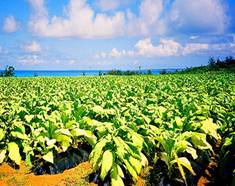
World Scenario (Figures in Million ha and tonne)
Country |
Area |
Production |
Productivity |
China |
1.38 |
2.75 |
2.00 |
India |
0.37 |
0.55 |
1.49 |
USA |
0.14 |
0.34 |
2.50 |
World |
3.90 |
6.72 |
1.72 |
(FAOSTAT, 2006)
Indian Scenario - 1998–(Figures in Million ha and tonne)
State |
Area |
Production |
Productivity |
AP |
0.20 |
0.19 |
0.98 |
Gujarat |
0.11 |
0.18 |
1.66 |
Karnataka |
0.07 |
0.06 |
0.87 |
UP |
0.02 |
0.15 |
6.83 |
Bihar |
0.02 |
0.01 |
0.72 |
WB |
0.01 |
0.01 |
0.57 |
TN |
0.005 |
0.008 |
1.46 |
India |
0.45 |
0.64 |
1.42 |
- Classification
- Nicotiana is broadly classified in to three sub-groups
- rustica
- tabacum
- Petunioides
- In India tabacum is widely cultivated and discussed here
|
Type |
Area |
1 |
FCV (Flue cured Virginia) |
AP, Karnataka |
2 |
Bidi |
Gujarat, Karnataka, |
3 |
Cigar & Cherrot |
TN, WB |
4 |
Hookah |
Assam, WB, Bihar, UP, Punjab |
5 |
Chewing & snuff |
TN, WB, Bihar, Assam, UP, Punjab |
6 |
Natu, Burley, Lanka, HDBRG |
AP |
7 |
Pikka |
Orissa |
Tobacco varieties cultivated in TN
- Cigar & Binder
- Vellaivazhai (VV 2)
- Kuruvazhai (KV 1)
- Country cheroot
- Narrow leaf Oosikappal ((I 737)
- Broad leaf Oosikappal (OK 1)
- Chewing tobacco
- Sun cured
- Monnai (I 64)
- Vazhaikappal (I 115)
- Vaadamugam(VD 1)
- Vattakkappal (VKT 1)
- Vedaranyam (VR 2)
- Smoke cured
- Periya vaadamugam (PV 7)
- Pit cured
- Vattakkappal (VTK 1), Vadamugam (VD 1)
Climate
- It is tropical in origin but successfully grown in temperate also
- 100-120 day frost free days
- Average temp of 26°C
- Sensitive Waterlogging
- Rainfall / irrigation during active vegetative growth is essential
Season
- Rabi planting
- 1st Fortnight of October
- In Vedaranyam after 15th Dec
- In Andra Pradesh
- Mid Oct to Mid Nov
- Early sowing ends with heavy rain
Nursery
- Well drained soil / raised bed
- 2.5m-2 for 1.0g seed
- 1.0g seed contains 10,000 seeds
- Seeds to seedling is very wide (10 :1)
- To transplant 20,000 seedlings 200,000 seeds in 50m-2 is more than sufficient
- Farmers use more than this area and seed rate
- Rabbing the nursery soil to prevent pest and disease is essential
- Manuring the nursery
- Irrigation by rose can
- Seedling age
- 7 weeks old
- Pull out seedlings are pencil thickness
- After pulling out selected seedlings top dress the remaining seedlings
Field preparation
- Soils of well drained
- Deep summer ploughing
- Ridges an furrows
- Apply heavy FYM 25 t/ha before last ploughing
Spacing
- Chewing tobacco
- 75 x 75 (17,777 plants/ha)
- Cigar tobacco
- 75 x 50 (26,666 plants/ha)
- Cheroot tobacco
- 60 x 45 (36,730 plants/ha)
Planting
- Transplant single seedlings of pencil thickness
- Irrigate the field prior to planting
- Make a hole and plant
- Cool hours or evening is preferable
- Gap filling within 7-10 days
Manuring
- N 100 kg/ha as Ammonium sulphate
- If brackish water restrict to 75kg
- 50% on 45th day and 50% 60 DAP
- Phosphorous
- 100 kg P2O5 as SSP at planting
- Potash
- Chewing – 50 kg K2O
- Cigar & Cheroot – 100 kg K2O
- In two splits along with N
Weeding and Intercultural operations
- Hand weeding three weeks after transplanting
- At 45 DAT soil mulching to make the ridge flat
- A week later deep furrowing to heavy irrigation at Grand growth period
Control of Orabanche
- Remove as and when shoot appear
- Removed shoots are to be burnt
- Trap crops
- Greengram, gingelly, sorghum
- Chemical weed control
- Fluchloralin @ 1.0 l/ha or
- Oxyflourfen 0.5 l/ha
- as pre-plant incorporation a week prior to planting
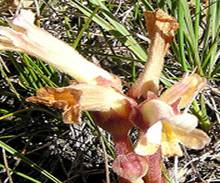
Toping
- Chewing tobacco: Top, leaving 10 leaves
Desuckering
- Removal of side shoots manually at weekly interval
- Application of neem oil emulsion at 35% after topping completely suppresses the suckers
- Neem oil 1.75 l + sandivit 0.5 l + water 2.75 l is needed for 1000 plants
Maturity & harvest
- Bulging of the intervenial portions of the leaf
- Appearance of brown spot on the leaves
- Cut the plant in the afternoon and allow it to wilt overnight
Cropping systems
- Mono-cropping is discouraged
- Crop rotation helps to maintain the soil fertility
- Intercropping is possible
- Onion and coriander (greens) are more suitable
POST HARVEST TECHNOLOGY FOR TOBACCO
Tobacco curing methods
- Curing is a carefully controlled process used to achieve the texture, colour and overall quality of a specific tobacco type. During the cure, leaf starch is converted into sugar, the green colour vanishes and the tobacco goes through colour changes from lemon to yellow to orange to brown like tree leaves in autumn. There are four main curing methods.
Flue-cured Tobacco
- The most common curing process is known as flue-curing
- Used mainly in the manufacture of cigarettes, the most common type of flue-cured tobacco is Virginia
- This tobacco is also known as 'bright tobacco' because the heat-drying process gives the leaves a bright, golden colour
- Originally from the south-eastern U.S. state of the same name, it is today the most grown tobacco variety in the world
- Flue-cured tobacco is dried in a closed building with furnace driven heat directed from flues or pipes that extend from a furnace into the barn.
- The temperature of the furnace is gradually raised until the leaves and stems are completely dried.
- Flue-curing takes about a week and fixes the natural sugar of the leaf, which has a high sugar and a medium-to-high nicotine content.
- Today, many farmers find that bulk curing flue-cured tobacco is far more cost-effective.
- Racks of tobacco are placed in bulk barns where heat and ventilation are controlled while air is forced through the leaves.
- Flue-cured varieties require warm weather, humidity, light rainfall and a sandy, loam soil for their four-month growing season.
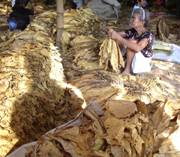
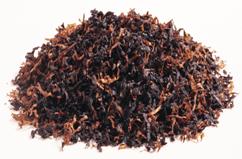
Air-cured Tobacco
- Some tobacco leaves are air-cured following their harvest.
- Air-cured tobacco is traditionally cured hanging in structures with a roof, but with open sides to allow air to freely circulate.
- As with flue-curing, the aim of air-curing is the timely removal of moisture from tobacco leaves. This process takes four to eight weeks:
- If cured too fast, the leaf will become patchy, if cured too slowly, the leaf will rot away.
- Commonly, air-cured tobacco is subdivided into dark air-cured and light air-cured tobacco.
- Burley is the second most popular tobacco in the world, belonging to the light air-cured variety.
- Burley, also known as White Burley tobacco, is primarily used to make cigarettes and aromatic blends, whereas dark air-cured tobaccos are mainly used in the production of chewing tobacco and snuff.
- Burley is a slightly smaller plant than the flue-cured Virginia type, but with similarly broad leaves.
- Once picked, its leaves are dried naturally – or ‘air-cured' – without the use of extra heat.
- This gives the leaves a light brown to mahogany appearance and very low sugar content.
- Burley tobaccos are somewhat cigar-like in taste and appearance, lending themselves to the production of flavoured, blended cigarettes commonly referred to as "American".
- Burley tobacco can be grown in limestone soils and requires only light fertiliser.

Fire-cured Tobacco
- Although curing methods may vary, all fire-cured tobaccos are subjected to wood smoke to dry the leaves. It is the type of wood used to smoke the tobacco leaves and the amount of smoke exposure that gives fire-cured tobacco leaves their distinctive flavours.
- Fire-cured tobacco, generally darker in colour, is used mostly for pipe tobacco mixtures, snuff, and chewing tobacco and has a low sugar but high nicotine content. Fire curing uses an enclosed barn similar to that used for flue-curing. Small fires are built on the floor, and the leaves cure in a smoke-laden atmosphere. Whereas flue-curing takes about a week, fire curing, using far lower temperatures, may take from a few days up to 4 weeks.
- Fire-cured tobacco is dried with low-burning wood fires on the floors of closed curing barns. The leaves have low sugar content but high nicotine content. Fire-cured tobacco is a robust variety of tobacco used as a condimental for pipe blends, cigarettes, chewing tobacco, snuff and strong-tasting cigars.
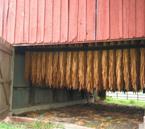
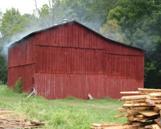
Sun-cured Tobacco
- A comparatively small amount of tobacco is sun-cured. Leaves are exposed to the sun to remove most of their moisture before being air-cured to complete the process. Of all sun-cured tobaccos, the best known are the so-called Oriental tobaccos of Turkey , Greece , Yugoslavia , and Balkans.
- A more labour-intensive product to harvest, Oriental tobacco is characterised by high aroma from small leaves, being low in both sugar and nicotine.
- The leaves are mostly sun-cured. Usually, the larger the leaf, the milder the aroma. Hence Oriental tobacco is regarded as expensive to harvest by many tobacco manufactures. Oriental tobaccos are often grown in poorer soils in southern Europe and the Middle East.
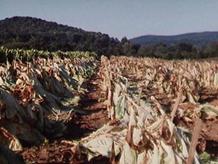
Grading
- Whereas after other curing processes tobacco is exposed to air to standardise the moisture content of the tobacco or “redry”, Oriental tobaccos are stored in bales and allowed to ferment. After storage, moisture is added to this type of tobacco. Pure – Turkish cigarettes contain 100% unblended Oriental tobacco – or blended, Oriental tobacco is mostly used in cigarettes, cigars, pipe, snuff or chewing tobacco.
- After curing, the farmer grades the leaves into different leaf positions, qualities and colours and packs his grades into what is known as a farmer bale of 30-50kg. He then takes his bales to a buying centre or auction for sale.
Multiple choice questions
- World production of tobacco is _________ m tonnes
-
a. 8.07 b. 9.07 c. 7.07
- Production of tobacco in India is _______ m tonnes
-
a. 0.54 b. 0.64 c. 0.74
- Tobacco variety suitable for cigar and binder making in Tamil Nadu is ____
-
a. Oosikappal (I 737) b. Vellaivazhai (VV 2) c. Vazhaikappal (I 115)
- Tobacco variety suitable for country cheroot making in Tamil Nadu is ____
-
a. Oosikappal (I 737) b. Vellaivazhai (VV 2) c. Vazhaikappal (I 115)
- Tobacco variety suitable for chewing tobacco in Tamil Nadu is ____
-
a. Oosikappal (I 737) b. Vellaivazhai (VV 2) c. Vazhaikappal (I 115)
- Following is a pit cured tobacco variety
-
a. Vedaranyam (VR 2) c. Vattakkappal (VTK 1)
c. Periya vaadamugam (PV 7)
- Following is a smoke cured tobacco variety
-
a. Vedaranyam (VR 2) b. Vattakkappal (VTK 1)
c. Periya vaadamugam (PV 7)
- Seed rate for tobacco is ______
-
a. 1 kg/ha b. 1 g/ha c. 2 g/ha d. 2 kg/ha
- Spacing recommended for chewing tobacco is _________
-
a. 75 x 50 cm b. 75 x 75 cm c. 60 x 45 cm
- Spacing recommended for cigar tobacco is _________
-
a. 75 x 50 cm b. 75 x 75 cm c. 60 x 45 cm
- Spacing recommended for cheroot tobacco is _________
-
a. 75 x 50 cm b. 75 x 75 cm c. 60 x 45 cm
- Recommended dose of potash for chewing tobacco is _______ kg/ha
-
a. 75 b. 100 c. 50
- Recommended dose of potash for cheroot and cigar tobacco is _______ kg/ha
-
a. 75 b. 100 c. 50
- Recommended dose of N and P for tobacco is _______ kg/ha
-
a. 75 : 100 b. 100 : 100 c. 50 : 75
- Trap crop used to control Orabanche is _________
-
a. Groundnut b. Maize c. Green gram
- The most common type of flue-cured tobacco is _________
-
a. Virginia b. Calcutta c. vilayati
- _________ tobacco is also known as 'bright tobacco'
-
a. Air-cured b. flue-cured c. fire cured
| Download this lecture as PDF here |
![]()